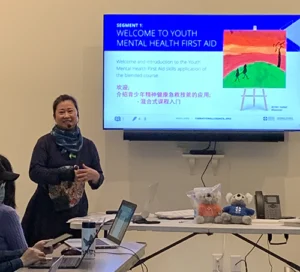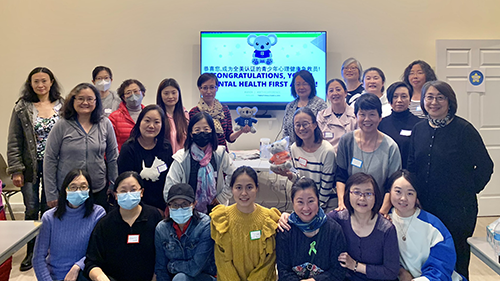“One in five adults in the United States is living with a mental illness, and I often ask myself, why can’t people talk about mental illness like they talk about cancer or heart disease?”

Elaine Peng is one of our valued Instructors for Adult and Youth Mental Health First Aid (MHFA) for Chinese-speaking Communities. Her journey and commitment to mental health advocacy began after her husband died from alcohol use disorder and her daughter was diagnosed with bipolar disorder . When Peng sought help for her own mental health challenges, she learned how to support herself and her daughter and was inspired to help others in the Chinese community.
Reflecting on her experiences, Peng shared, “My daughter’s recovery shows that treatment works, and I want others to know they’re not alone.”
Research estimates that 57.8 million people across the U.S. are experiencing challenges with various mental illnesses. Despite this, societal biases against mental health issues persist. Mental illnesses can be effectively treated, but there is a societal tendency to view mental illness differently from physical ailments. This stigma is particularly prevalent in Asian communities, where studies highlight it as the main barrier that prevents Asian Americans from seeking help.
Peng noted, for example, that in Alameda County, California, Asians make up 29% of the population, but they make up only 2% in the public mental health system. “Does that mean Asians are 15 times healthier mentally than other ethnicities? Of course not,” she said. “Too many Chinese Americans struggling with mental illness are still suffering in silence, like my husband, who died of the illness.”
Peng is working to increase awareness of mental health education and help people identify symptoms early and seek professional help quickly, just as they would for a physical ailment. Her goal is to bring MHFA programs into the Chinese community to prevent others from experiencing what she and her family went through.
Historically marginalized communities, such as Black, Indigenous and people of color (BIPOC) communities, face disproportionate challenges around access to and quality of mental health and substance use care. The Chinese community faces unique mental health challenges for cultural and structural reasons. Peng highlights these two factors:
Cultural factors: stigma
Deep-rooted cultural stigmas surrounding mental illness are a significant barrier. The perception of mental illness as a personal failing or a sign of weakness discourages individuals from seeking help.
In Chinese culture, the brain is regarded as the organ that governs all aspects of functioning. Consequently, mental health challenges are often perceived as indicative of a fundamental flaw in the brain, the command center of the body. This perception leads to the belief that individuals with mental health challenges are unreliable or unfit for social interaction, resulting in a perceived loss of social status.
The concept of “face” (面子, miànzi), which is associated with a person’s public image and honor, makes it hard for people to seek help because they worry about losing face or disrupting social harmony. Instead, there is a lot of pressure to handle problems on one’s own.
Structural factors: limited resources
The lack of culturally and linguistically appropriate mental health services for Chinese communities creates a barrier to access. This includes a shortage of bilingual therapists and culturally sensitive treatment models.
Together, these factors create a complex environment that discourages Chinese American individuals from seeking help. The cultural stigma, compounded by the lack of accessible and culturally competent resources, leads to feelings of isolation and despair.
Peng notes that tackling both cultural stigma and structural barriers can create positive change to address mental health challenges within Chinese communities. Her recommendations include:
Recognizing the diversity of our communities, MHFA recently developed culturally tailored Adult and Youth MHFA for various groups, including trainings for Chinese-speaking communities. These courses retain the integrity of the original content while addressing unique cultural needs and nuances. Individuals within Chinese communities have access to resources that not only acknowledge but also understand and address the cultural factors that may influence perceptions around mental health. The training modules educate individuals on recognizing and responding to mental health or substance use challenges within their communities while being mindful of cultural differences. The courses emphasize the importance of respecting diverse perspectives and acknowledging that one size does not fit all when it comes to mental health support.
To help address racial inequities and the associated stigmas that lead to disparities, the National Council for Mental Wellbeing built a directory of resources to support your community with tools and learning opportunities.
As a leader in developing mental health programs for the Chinese American community, Peng notes that the importance of tailoring support strategies for specific groups. She has noticed that traditional support group models may not always resonate with the Chinese community and prioritizes activities grounded in cultural preferences, like picnics, fishing trips and public celebrations. Culturally sensitive activities improve engagement and create a sense of belonging, which are essential for overcoming stigma and encouraging people to seek help. Add to that a strong focus on education and awareness, and ensure accessibility and adaptability, and you can collectively empower people, reduce stigma, and promote mental wellbeing within the Chinese American community.

Elaine Peng (front row, third from right) with a Youth MHFA for Chinese-speaking Communities class.
Looking ahead, Elaine hopes to continue providing access to mental health education within Chinese communities. She encourages individuals who are struggling, as well as mental health advocates, to join support networks and collaborate to amplify their impact.
Mental Health First Aiders can search for available courses in their preferred language through the Mental Health First Aid Find a Course tool. This tool can also be used to find and connect with MHFA Instructors certified in community-specific courses of interest. If there’s nothing available, First Aiders can consider becoming a MHFA Instructor to lead the way and bring courses to their community.
